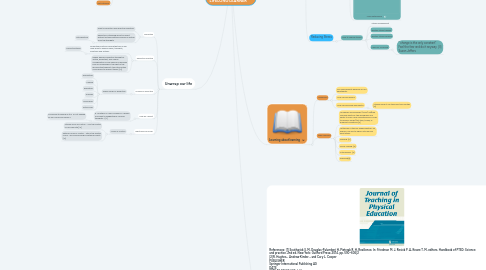
1. Healthy Body & Mind
1.1. Physical Activity
1.1.1. The way we navigate the world if our physical literacy is not good our mental and overall health will suffer.
1.2. Physical Literacy
1.2.1. physical literacy can be defined “as having the motivation, confidence, physical competence, knowledge and understanding that underpin someone's values and responsibilities for life-long purposeful physical pursuits” Whitehead Margaret [4]
1.2.1.1. Physical literacy means getting back in touch with our physical selves by getting outdoors, exercising and enjoying physical activity. The body does and the mind will follow.
1.2.1.1.1. My physical literacy plan:
1.2.1.1.2. Get outside more walking and bike riding
1.2.1.1.3. Get involved in sport
1.2.1.1.4. Regular daily exercise. Do something everyday.
1.2.1.1.5. Our physical literacy journey [5}
1.2.1.1.6. People Events . Transitions
1.3. Improving our physical self[7]
1.3.1. Recommended amounts of weekly physical activity
1.3.2. 150 mins of moderate exercise [6]
1.3.3. 75 mins of vigorous exercise [6]
1.3.4. Maintains health
1.3.5. Improves sleep
1.3.6. Manages stress
1.3.7. Improves quality of life
1.3.8. Prevents
1.3.9. Cancer
1.3.10. Diabetes
1.3.11. Pains
1.3.12. Depression
1.3.13. Improve strength
1.3.14. Improve stamina
1.3.15. Minimize staying still
1.3.16. Every little helps
1.3.17. Strive for:
1.3.18. Healthy Eating
1.3.19. Better Sleep
1.3.20. Less sitting
1.3.21. Get outdoors
2. Unwrap our life
2.1. Reflection
2.1.1. What is reflection and reflective practice?
2.1.2. Reflection is thinking about an event without actually getting involved in acting from the thoughts.
2.1.2.1. Introspection
2.2. Reflective Practice
2.2.1. Reflective practice is using that skill in our daily work to analyse ideas, thoughts, emotions and actions.
2.2.1.1. More structured
2.2.2. Dewey defined reflective thought as ‘active, persistent, and careful consideration of any belief or supposed form of knowledge in the light of the grounds that support it and the further conclusions to which it tends’ [10]
2.3. Models of reflection
2.3.1. Gibbs Model of Reflection
2.3.1.1. Description
2.3.1.2. Feeling
2.3.1.3. Evaluation
2.3.1.4. Analysis
2.3.1.5. Conclusion
2.3.1.6. Action Plan
2.4. How we reflect
2.4.1. R. Jonathan “A man is shown in a dream only what is suggested by his own thoughts…”[11]
2.4.1.1. Do we see th eworld as it is or is it shaped by our norms and values ?
2.5. What drives our life?
2.5.1. Locus of Control
2.5.1.1. Internal locus of control - I am the master of my own fate [13]
2.5.1.2. External locus of control - fate is the master of me. I am moved along by external events [13]
3. Moving forward
3.1. Resilience
3.1.1. The American Psychological Association (2014) defines resilience as “the process of adapting well in the face of adversity, trauma, tragedy, threats or even significant sources of stress (para. 4).” [1]
3.1.2. Components of resilience [2]
3.1.2.1. How can I be more resilient?
3.1.3. Mood
3.1.3.1. Not taking things to heart
3.1.4. Self worth
3.1.4.1. Valuing myself ( Treasure life)
3.1.4.2. Set goals that connect with my mission in life
3.1.5. Self Control
3.1.5.1. Being more courageous
3.1.5.2. More determined
3.2. Reducing Stress
3.2.1. How to reduce stress?
3.2.1.1. Stress management
3.2.1.2. Identify stress triggers
3.2.1.3. Identify stress blockers
3.2.1.4. FEAR OF CHANGE
3.2.1.4.1. “ change is the only constant” Feel the fear and do it anyway [3] Susan Jeffers
4. Learning about learning
4.1. Unlearning
4.1.1. Our employability depends on our adaptability
4.1.2. How can we relearn?
4.1.3. How can we break bad habits?
4.1.3.1. Studies show it can take over two months [8]
4.2. Agile Learning
4.2.1. Lombardo and Eichinger (2000) defined learning agility as “the willingness and ability to learn. new competencies in order to perform under first-time, tough, or different conditions”[9]
4.2.2. Letting go of the old. Experimenting. Try, explore, fail and try again until we find what works.
4.2.3. Seeking. [9]
4.2.4. Sense Making. [9]
4.2.5. Internalising. [9]
4.2.6. Applying[9]

